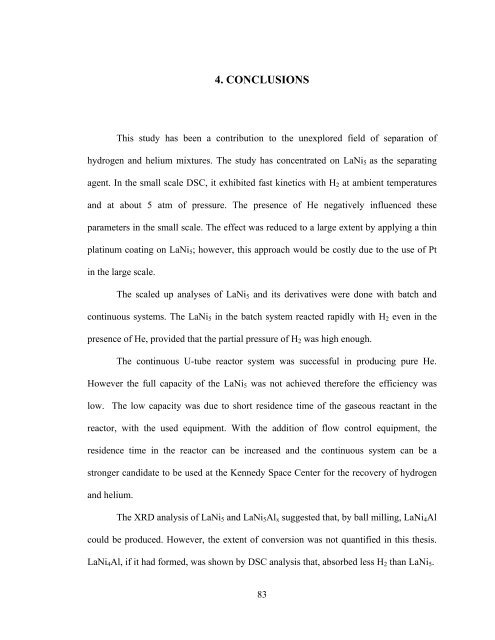Create successful ePaper yourself
Turn your PDF publications into a flip-book with our unique Google optimized e-Paper software.
4. CONCLUSIONS<br />
This study has been a contribution to the unexplored field of separation of<br />
hydrogen and helium mixtures. The study has concentrated on LaNi 5 as the separating<br />
agent. In the small scale DSC, it exhibited fast kinetics with H 2 at ambient temperatures<br />
and at about 5 atm of pressure. The presence of He negatively influenced these<br />
parameters in the small scale. The effect was reduced to a large extent by applying a thin<br />
platinum coating on LaNi 5 ; however, this approach would be costly due to the use of Pt<br />
in the large scale.<br />
The scaled up analyses of LaNi 5 and its derivatives were done with batch and<br />
continuous systems. The LaNi 5 in the batch system reacted rapidly with H 2 even in the<br />
presence of He, provided that the partial pressure of H 2 was high enough.<br />
The continuous U-tube reactor system was successful in producing pure He.<br />
However the full capacity of the LaNi 5 was not achieved therefore the efficiency was<br />
low. The low capacity was due to short residence time of the gaseous reactant in the<br />
reactor, with the used equipment. With the addition of flow control equipment, the<br />
residence time in the reactor can be increased and the continuous system can be a<br />
stronger candidate to be used at the Kennedy Space Center for the recovery of hydrogen<br />
and helium.<br />
The XRD analysis of LaNi 5 and LaNi 5 Al x suggested that, by ball milling, LaNi 4 Al<br />
could be produced. However, the extent of conversion was not quantified in this thesis.<br />
LaNi 4 Al, if it had formed, was shown by DSC analysis that, absorbed less H 2 than LaNi 5 .<br />
83



